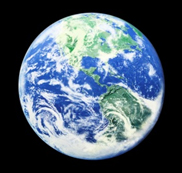
Some numbers we use are simply too large to efficiently write out. For example, the mass of the Earth is 5,980,000,000,000,000,000,000,000 kilograms. This is a really large number, and it may be difficult to keep track of all of the zeros.

Let’s learn a strategy that can help in situations like this.
Look at the following three examples:
30 = 3 x 10
600 = 6 x 100
800,000 = 8 x 100,000
Use what you observed to complete the two number sentences below.
What are we doing in each of these examples?
Interactive popup. Assistance may be required. We are writing bigger numbers as a small number times a power of 10.
![]() Watch the following video as it applies this fact and what we learned in section 1 to the number 7,560,000,000.
Watch the following video as it applies this fact and what we learned in section 1 to the number 7,560,000,000.
Scientific notation writes very large numbers as a coefficient times 10 raised to an exponent:
When writing a number in scientific notation the coefficient must have a value that is greater than or equal to 1 and less than 10.
In the example in the video, what was the coefficient?
Interactive popup. Assistance may be required. 7.56
What was the exponent?
Interactive popup. Assistance may be required. 9
![]()
What exponent should we use to write the power of 10 for the mass of the earth?
Interactive popup. Assistance may be required. 24
What is the mass of the earth written in scientific notation?
Interactive popup. Assistance may be required. 5.98 x 1024 kilograms
How many places was the decimal point moved to convert to scientific notation?
Interactive popup. Assistance may be required. The decimal was moved 24 spaces to the left.

Sometimes we are faced with numbers that are very large, but other times, we must work with numbers that are very small. For example, the mass of a dust particle is 0.000000000753 kilograms.
If the mass a dust particle is written in scientific notation, what will be the coefficient?
Interactive popup. Assistance may be required. The coefficient should be 7.53.
What is the first digit in the coefficient?
Interactive popup. Assistance may be required. 7
In which decimal place is that number?
Interactive popup. Assistance may be required. The 7 is in the 10th decimal place.
From the rule that you generated in section 2 of this resource, how would you write 10 raised to a power so that it would equal a decimal that has a 1 in the 10th decimal place?
Interactive popup. Assistance may be required. 10-10
How would you write the mass of a dust particle in scientific notation?
Interactive popup. Assistance may be required. 7.53 x 10-10 kilograms.
How many places, and in what direction, was the decimal point moved to convert 0.000000000753 kilograms.to scientific notation?
Interactive popup. Assistance may be required. The decimal was moved 10 places to the right.
Important note:
The negative sign means that this is a decimal between 0 and 1, it does not make the number itself negative. To write a negative number in scientific notation, you need to make the coefficient negative.